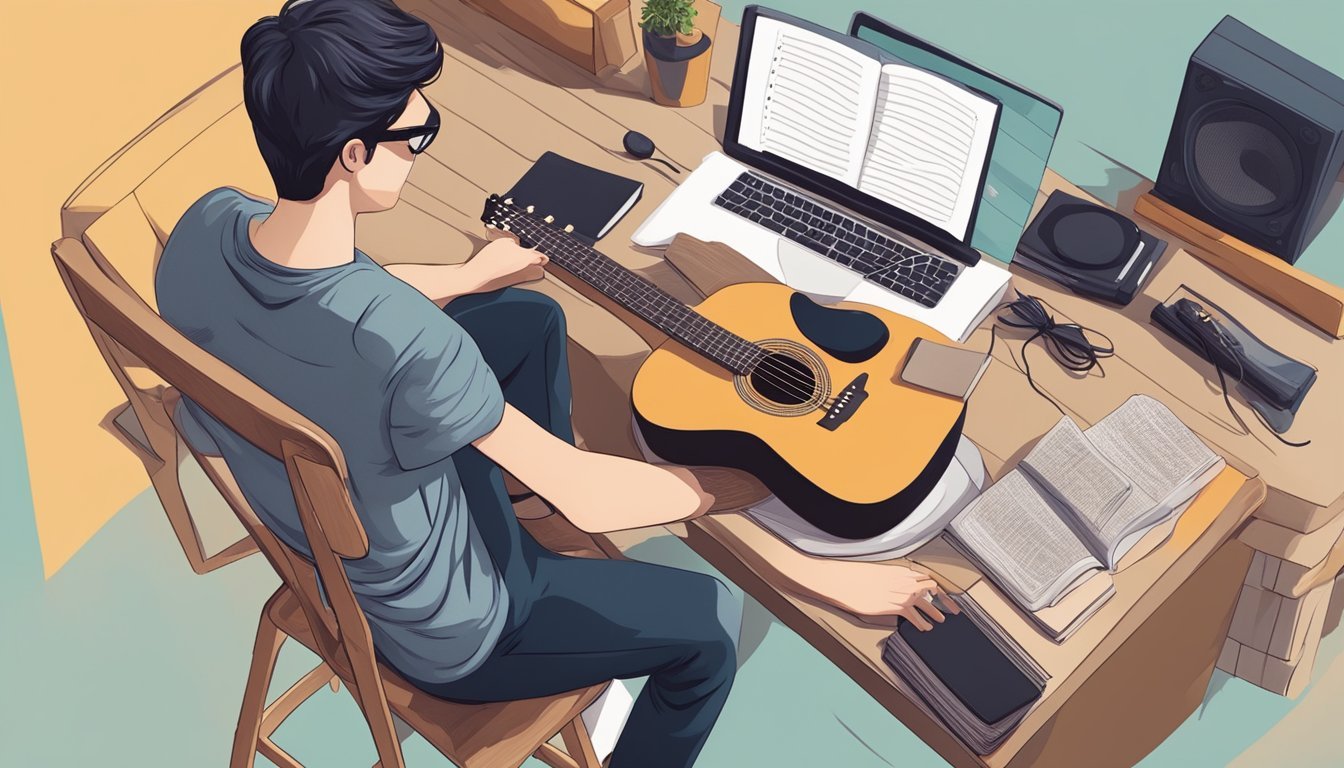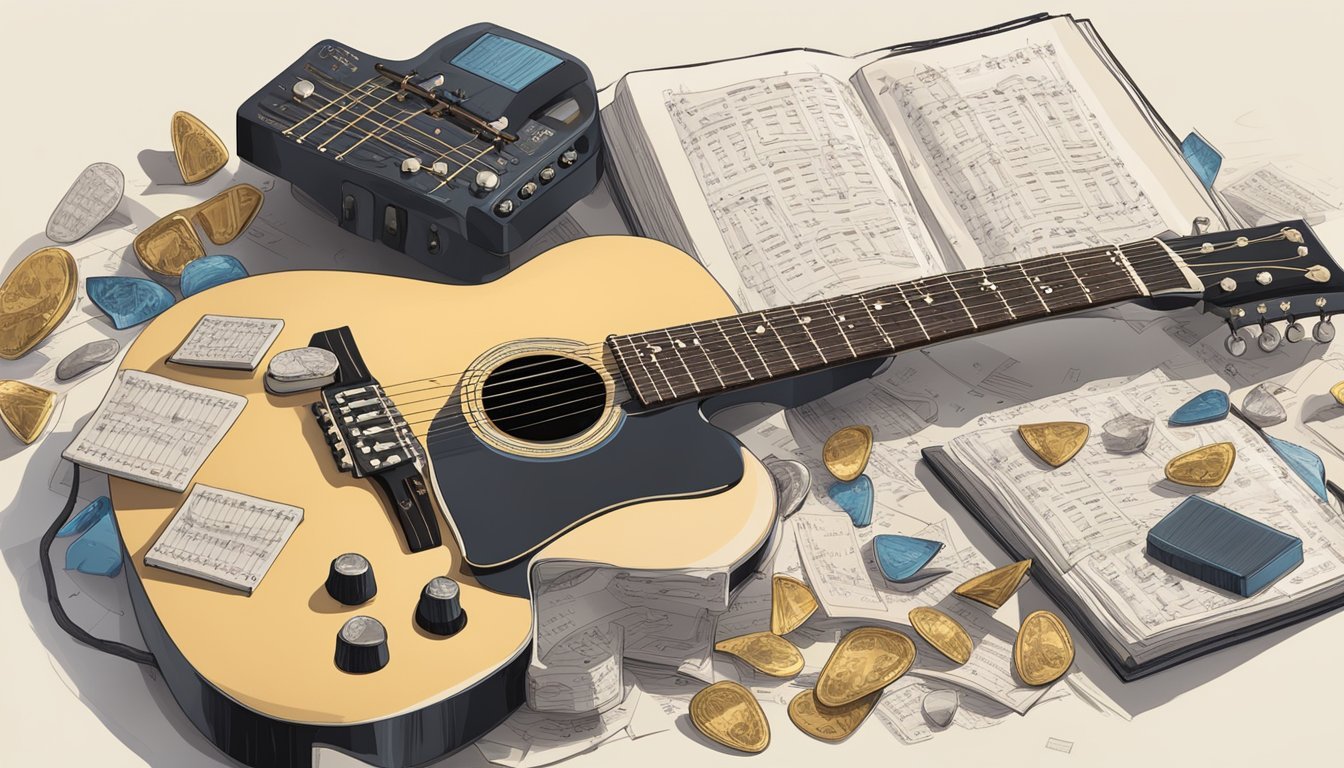Learning to play the guitar can be an exciting adventure.
You can teach yourself how to play guitar effectively by following some simple steps and staying motivated.
Whether you’re a complete beginner or have some music background, this journey is all about discovering what works best for you.

Start by choosing the right guitar for your needs and get familiar with its parts.
From there, focus on the basics, like chords and finger exercises, to build your foundation.
The key is to practice regularly and find enjoyment in the process, which will help you progress faster.
As you advance, challenge yourself with new songs and techniques to keep things interesting.
Remember, self-taught guitarists often develop unique styles, so embrace your creativity along the way.
Key Takeaways
- Choose an instrument that suits you to kickstart your learning.
- Establish a consistent practice schedule for better skills development.
- Explore different genres and techniques to enhance your guitar playing.
Choosing Your Instrument
When starting your journey to self-teach guitar, picking the right instrument is key.
You’ll need to decide between an electric or acoustic guitar, consider specific features, and gather essential accessories.
Here’s what you should know to make the best choice.
Electric vs Acoustic Guitars
The first choice you’ll face is whether to go with an electric or acoustic guitar. Electric guitars are known for their versatility, allowing you to play a variety of styles, from rock to jazz.
They require an amplifier, which adds to the cost.
On the other hand, acoustic guitars are more straightforward.
They are great for playing anywhere without needing extra gear.
If you want a warm, natural sound, this might be the way to go.
Think about the music you want to create.
If you enjoy strumming chords alone or singing along, an acoustic might suit you well.
What to Look for in a Guitar
When choosing a guitar, consider a few key features.
First, look at the body size.
Smaller bodies are easier to handle, especially for beginners.
Next, check the fingerboard radius.
A flatter fingerboard (around 12 inches) can make it easier for you to play single notes and solos.
Also, pay attention to the wood type.
Spruce tops provide a bright sound, while mahogany gives a warmer tone.
Don’t forget to try out the guitar in person.
Make sure it feels comfortable, and the strings aren’t too hard to press down.
A friendly shop employee can help you with that.
Guitar Accessories Essentials
With your guitar picked out, you’ll need a few essential accessories to enhance your playing experience.
A good guitar tuner is a must.
Keeping your guitar in tune makes a huge difference in sound quality.
You can find clip-on tuners or smartphone apps that work great.
Next, grab some guitar picks.
Those come in different thicknesses, so try a few to see which feels best for you.
A padded gig bag is also smart, as it protects your guitar from damage while transporting.
Investing in a comfortable strap can make your playing sessions more enjoyable.
These accessories help you play better and keep your gear safe!
Getting Started with the Basics

Starting your guitar journey means getting familiar with the instrument itself and learning some essential skills.
Understanding guitar anatomy, chords, and how to read tablature will set a solid foundation for your playing.
Understanding Guitar Anatomy
Before you start strumming, it’s good to know your guitar’s parts.
A typical guitar has several components:
- Body: This is the main part that produces sound.
- Neck: The long part where you place your fingers.
- Fretboard: The surface of the neck with metal strips called frets.
- Headstock: The top part where the tuning pegs are located.
Knowing these parts helps you understand how to hold and care for your guitar.
It also prepares you to learn how to tune your instrument, which is crucial for good sound.
Learning Guitar Chords and Scales
Chords are a big part of playing guitar.
Start with open chords, like C, G, and D. These are the basics and great for beginners.
Here’s a quick list of important chords you might want to learn:
- A Major
- E Minor
- D Major
After mastering chords, move on to scales.
The major scale is a great choice.
It helps you understand melody and improvisation.
Spend time practicing these daily.
Using a chord chart can make learning easier.
Reading Guitar Tablature
Guitar tablature, or tab, shows you where to place your fingers on the fretboard.
It’s a simple way to read music for guitar.
Each line represents a string, and the numbers tell you which fret to press.
Here’s a basic example of a simple tab:
e|-----0-----
B|-----1-----
G|-----0-----
D|-----2-----
A|-----3-----
E|----------
This tab shows you how to play a C major chord.
Take your time learning to read tabs.
They are widely used and can help you learn countless songs quickly.
Developing Effective Practice Routines
Setting up a solid practice routine will help you build your skills and keep your guitar journey enjoyable.
Focus on having a clear plan, working on essential techniques, and understanding music theory.
Creating a Practice Schedule
Start by creating a practice schedule that fits your life.
Aim for at least 15-30 minutes daily.
Consistency is key.
Choose specific times, whether in the morning or evening, when you can focus without distractions.
To make it easier, break your practice into segments.
For example:
- 5 minutes: Warm up with finger exercises
- 10 minutes: Work on chords or new songs
- 10 minutes: Focus on strumming patterns
This structured approach ensures you cover various skills without feeling overwhelmed.
Keep track of your progress and adjust your schedule as needed.
Finger Exercises and Techniques
Finger exercises are crucial for building strength and agility.
They help with your finger independence and coordination.
Start with simple exercises, like scales or finger drills.
Try these exercises for about 5-10 minutes each session:
- Chromatic Scale: Play each note from the lowest string to the highest.
- Fingering Patterns: Use different combinations of fingers on each string.
Make sure to focus on your strumming technique while practicing chords.
Try varying your strumming patterns, like down and up strums, to keep it interesting.
Learning and Applying Music Theory
Understanding basic music theory will elevate your playing.
Start with learning the names of the strings, chord progressions, and key signatures.
This knowledge helps you grasp how songs are built.
Create a learning plan that includes:
- Concepts like intervals and scales
- Applying these ideas to songs you play
- Experimenting with different strumming patterns
As you learn, apply these concepts directly to your practice sessions.
This will strengthen your skills and give you more confidence.
Use resources like online lessons or apps to support your learning.
Advancing Your Skills

To keep growing as a guitarist, it’s essential to engage with the music you love, try different styles, and learn advanced techniques.
Here’s how you can take your skills to the next level.
Playing Songs You Love
Learning to play songs you enjoy can motivate you more than anything else.
Start by picking a few of your favorite songs.
It helps if they have simple chords that you can practice.
Websites with chord charts can be useful for this.
You can find many popular songs that only use a handful of chords, like C, G, and D. Focus on playing along with recordings to improve your timing and rhythm.
This practice will not only boost your skills but also your musicality.
As you build confidence, challenge yourself with slightly harder songs.
You might even consider online guitar lessons to learn specific techniques used in your favorite tracks.
Don’t hesitate to explore various genres; it will make your playing more versatile.
Exploring Different Music Genres
Diving into different music genres can expand your musical knowledge and skills.
Each genre has its own techniques and styles.
For instance, playing blues involves a lot of bends and slides, while classical guitar focuses on fingerpicking.
Try listening to different genres like rock, jazz, or folk.
Identify their unique rhythms and guitar tricks.
You can even find online tutorials that focus on these styles.
Experimenting with various genres broadens your understanding of music theory, harmonies, and structures.
It can inspire you to write your own songs, making your learning experience even richer.
Mastering Advanced Guitar Techniques
Once you feel comfortable with the basics, it’s time to tackle advanced techniques.
Techniques like hammer-ons, pull-offs, and palm muting will take your playing to the next level.
These skills can add flair and complexity to your music.
Consider taking lessons that focus on advanced techniques.
A good guitar teacher can provide personalized tips and help refine your style.
Online guitar lessons can also be a flexible option for learning.
Many learners find that a structured approach helps them make faster progress.
If you’re considering in-person lessons, be sure to check the guitar center lesson pricing details to find a plan that fits your budget.
Ultimately, whether you choose online or face-to-face instruction, the right guidance can make a significant difference in your musical journey.
Practice regularly, setting small goals for each session.
Use skill-building exercises to develop muscle memory.
Over time, these advanced techniques will become second nature, enhancing your overall musicianship.
Frequently Asked Questions
When starting on your guitar journey, it’s normal to have questions.
Here’s some specific guidance to help you navigate the learning process and make the most of your time.
What’s the best way to start learning guitar on your own?
Start by creating a comfortable learning space.
Read about guitars to know the basics, and practice the fundamental chords.
Choose simple songs to play, and don’t forget to enjoy the process!
Can you really learn guitar without a teacher, and if so, how?
Yes, you can definitely teach yourself guitar.
Use online tutorials, videos, and song sheets.
Consistent practice is key, so set aside time daily to work on new skills and songs.
Are there any free resources that are good for self-taught guitar beginners?
There are plenty of free resources available online.
Websites and YouTube channels offer lessons for beginners.
Look for beginner-friendly song lists and instructional videos to get you started.
How much time should I expect to spend to get decent at guitar if I’m teaching myself?
If you practice regularly, you can expect to see progress in a few months.
Aim for 20-30 minutes of practice each day.
Patience is important, so give yourself time to improve.
What steps should I take to teach myself guitar from scratch?
Begin with learning the parts of the guitar and how to tune it.
Then, focus on basic chords and practice switching between them.
Break songs into sections to make learning easier.
Which chords should I learn first when teaching myself guitar?
Start with the major chords like C, G, D, and E. These chords are commonly used in many songs.
Once you’re comfortable, you can add minor chords like A minor and E minor to your skills.

